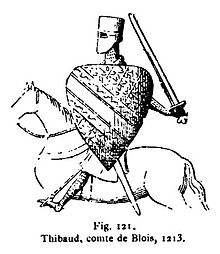
Theobald VI of Blois (French: Thibaut) (died 1218) was count of Blois and Clermont-en-Beauvaisis from 1205 to 1218.
He was son of Louis I of Blois and Catherine of Clermont. [1]
Theobald married twice: with Maud of Alençon [1] and with Clemence of Roches, but remained childless. Clemence married Geoffrey VI, Viscount of Châteaudun, as her second husband.
Theobald fought the Moors in Castile. [2] During the campaign he contracted leprosy and returned home. [2] After living withdrawn in his castle in La Ferté-Villeneuil for a few years, Theobald died in 1218, leaving his possessions to his aunts Margaret and Isabelle. The northern part of Blois was erected into the County of Chartres for Isabelle; Margaret received the remainder of the County of Blois, and his heirs sold Clermont to Philip II of France. [3]
